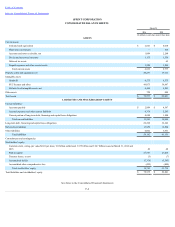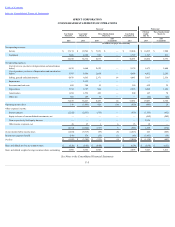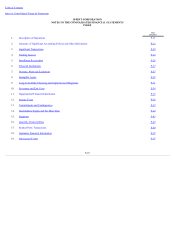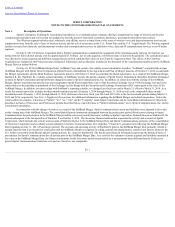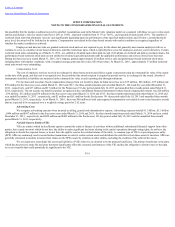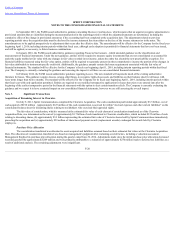Sprint - Nextel 2015 Annual Report Download - page 98
Download and view the complete annual report
Please find page 98 of the 2015 Sprint - Nextel annual report below. You can navigate through the pages in the report by either clicking on the pages listed below, or by using the keyword search tool below to find specific information within the annual report.
Table of Contents
Index to Consolidated Financial Statements
SPRINT CORPORATION
NOTES TO THE CONSOLIDATED FINANCIAL STATEMENTS
Property, Plant and Equipment
Property, plant and equipment (PP&E), including improvements that extend useful lives, are recognized at cost. Depreciation on property, plant and
equipment is generally calculated using the straight-line method based on estimated economic useful lives of 3 to 30 years for buildings and improvements and
network equipment, site costs and related software and 3 to 12 years for non-network internal use software, office equipment and other. Leasehold improvements
are depreciated over the shorter of the lease term or the estimated useful life of the respective assets. Leased devices are depreciated using the straight-line method
to their estimated residual value generally over the term of the lease. We calculate depreciation on certain network assets using the group life method. Accordingly,
ordinary asset retirements and disposals on those assets are charged against accumulated depreciation with no gain or loss recognized. Gains or losses associated
with all other asset retirements or disposals are recognized in the consolidated statements of operations. Depreciation rates for assets are revised periodically to
account for changes, if any, related to management's strategic objectives, technological changes, estimated residual values, or obsolescence. Changes in our
estimates will result in adjustment to depreciation prospectively over the estimated useful lives of our non-leased assets and over the remaining period of benefit
for devices leased to our customers. Repair and maintenance costs and research and development costs are expensed as incurred.
We capitalize costs for network and non-network software developed or obtained for internal use during the application development stage. These costs
are included in PP&E and, when the software is placed in service, are depreciated over estimated useful lives of three to five years. Costs incurred during the
preliminary project and post-implementation stage, as well as maintenance and training costs, are expensed as incurred.
Long-Lived Asset Impairment
Sprint evaluates long-lived assets, including intangible assets subject to amortization, for impairment whenever events or changes in circumstances
indicate that the carrying amount of an asset group may not be recoverable. Asset groups are determined at the lowest level for which identifiable cash flows are
largely independent of cash flows of other groups of assets and liabilities. When the carrying amount of a long-lived asset group is not recoverable and exceeds its
fair value, an impairment loss is recognized equal to the excess of the asset group’s carrying value over the estimated fair value. See Note7.Property,Plantand
Equipmentfor additional information on long-lived asset impairments.
Certain assets that have not yet been deployed in the business, including network equipment, cell site development costs and software in development,
are periodically assessed to determine recoverability. Network equipment and cell site development costs are expensed whenever events or changes in
circumstances cause the Company to conclude the assets are no longer needed to meet management's strategic network plans and will not be deployed. Software
development costs are expensed when it is no longer probable that the software project will be deployed. Network equipment that has been removed from the
network is also periodically assessed to determine recoverability. If we experience significant operational challenges, including retaining and attracting subscribers,
future cash flows of the Company may not be sufficient to recover the carrying value of our wireless asset group, and we could record asset impairments that are
material to Sprint's consolidated results of operations and financial condition.
Indefinite-Lived Intangible Assets
Our indefinite-lived intangible assets primarily consist of goodwill, certain of our trademarks and FCC licenses. Goodwill represents the excess of
consideration paid over the estimated fair value of the net tangible and identifiable intangible assets acquired in business combinations. In determining whether an
intangible asset, other than goodwill, is indefinite-lived, we consider the expected use of the assets, the regulatory and economic environment within which they
are being used, and the effects of obsolescence on their use. We assess our indefinite-lived intangible assets, including goodwill, for impairment at least annually
or, if necessary, more frequently, whenever events or changes in circumstances indicate the asset may be impaired.
These analyses, which include the determination of fair value, require considerable judgment and are highly sensitive to changes in underlying
assumptions. Consequently, there can be no assurance that the estimates and assumptions made for the purposes of estimating the fair values of our indefinite-lived
assets, including goodwill, will prove to be an accurate prediction of the future. Continued, sustained declines in the Company’s operating results, forecasted future
cash flows, growth rates and other assumptions, as well as significant, sustained declines in the Company’s stock price and related market capitalization could
impact the underlying key assumptions and our estimated fair values, potentially leading to a
F-14


